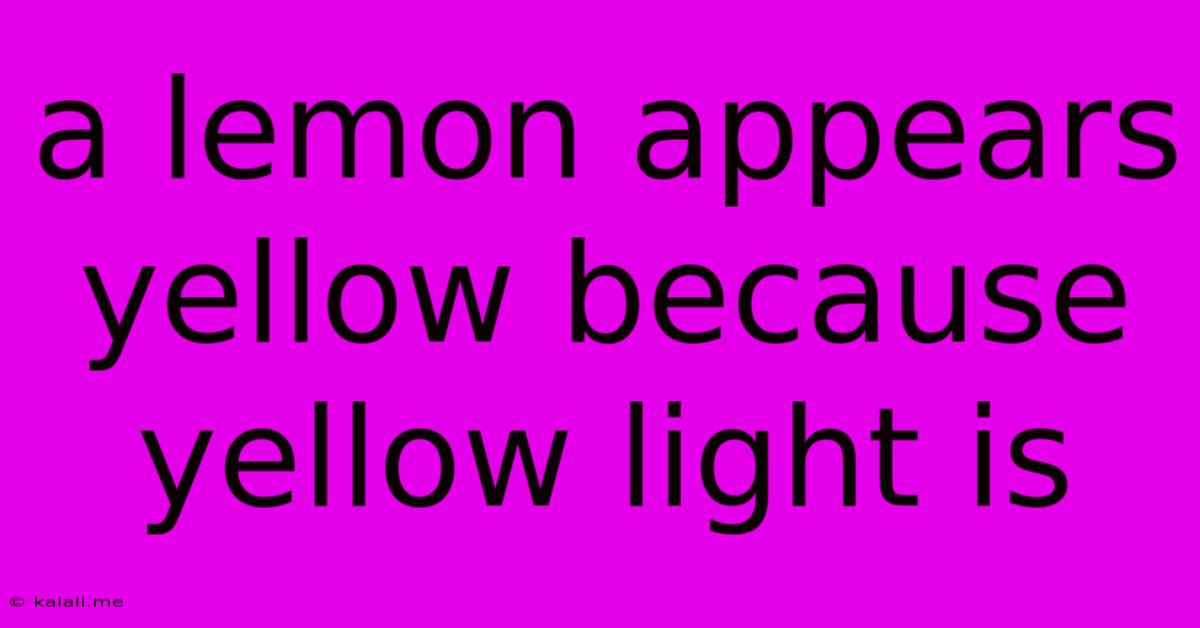A Lemon Appears Yellow Because Yellow Light Is
Kalali
Jun 10, 2025 · 3 min read

Table of Contents
A Lemon Appears Yellow Because Yellow Light is...Reflected!
Why do lemons appear yellow? It's not because lemons absorb yellow light, but rather because they reflect it. This seemingly simple answer delves into the fascinating world of light, color perception, and the pigments within the lemon's peel. Understanding this principle is crucial for anyone interested in color theory, photography, or even just appreciating the beauty of nature.
The Science of Color and Light
Light, as we know it, is composed of a spectrum of colors. This spectrum includes red, orange, yellow, green, blue, indigo, and violet – ROYGBIV. When white light, like sunlight, hits an object, several things can happen. The object can:
- Absorb: The object takes in certain wavelengths of light.
- Reflect: The object bounces back certain wavelengths of light.
- Transmit: The object allows certain wavelengths of light to pass through it (transparency).
Lemons appear yellow because their peel primarily reflects yellow light wavelengths. The other wavelengths, such as blue and green, are mostly absorbed by the pigments in the lemon's rind. This selective reflection is what allows us to perceive the lemon as yellow.
The Role of Pigments in Lemon Peel
The yellow color of a lemon is due to carotenoids, a group of pigments found abundantly in plants. These pigments are responsible for the vibrant hues of many fruits and vegetables. Specifically, lemons contain lutein and zeaxanthin, two types of carotenoids that strongly reflect yellow light. These pigments absorb light in the blue and green regions of the spectrum, leaving the yellow light to be reflected back to our eyes.
Why Doesn't it Appear White?
You might wonder, if white light contains all colors, why doesn't the lemon appear white? This is because the pigments in the lemon peel selectively absorb specific wavelengths of light. The absorption of these wavelengths removes them from the reflected light, leaving behind primarily the yellow wavelengths that reach our eyes, creating the perception of a yellow fruit.
Beyond the Simple Explanation: Factors Affecting Color Perception
While the reflection of yellow light is the primary reason for a lemon's yellow appearance, other factors can subtly influence its perceived color:
- Lighting Conditions: The intensity and type of light source significantly affect color perception. Under different lighting conditions (e.g., incandescent, fluorescent, sunlight), the lemon might appear slightly different shades of yellow.
- Ripeness: The color intensity of a lemon can vary depending on its ripeness. Unripe lemons may have a greener hue due to a higher concentration of chlorophyll.
- Variety: Different lemon varieties may possess slightly different pigment concentrations, leading to variations in their yellow shades.
In conclusion, the simple answer—a lemon appears yellow because it reflects yellow light—is a fundamental concept in the science of color. However, understanding the intricate interplay of light, pigments, and other factors provides a richer appreciation for this seemingly basic observation. This detailed understanding also makes it easier to grasp more complex color-related concepts in photography, design, and other fields.
Latest Posts
Latest Posts
-
How To Change Name On Twitter
Jun 10, 2025
-
How Long Wait To Stain Pressure Treated Wood
Jun 10, 2025
-
My Honda City Will Not Start
Jun 10, 2025
-
Objects Will Always Attract Charged Objects
Jun 10, 2025
-
How Long Do Pickled Eggs Last Without Refrigeration
Jun 10, 2025
Related Post
Thank you for visiting our website which covers about A Lemon Appears Yellow Because Yellow Light Is . We hope the information provided has been useful to you. Feel free to contact us if you have any questions or need further assistance. See you next time and don't miss to bookmark.